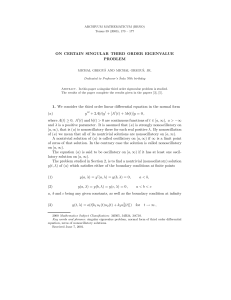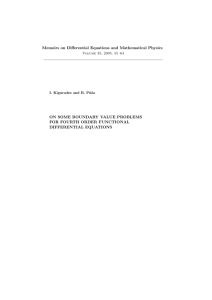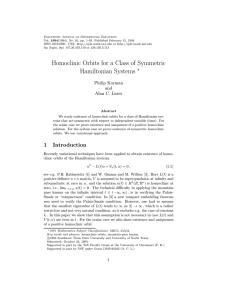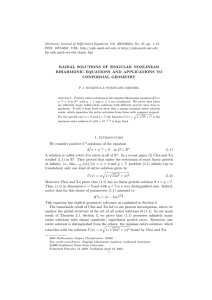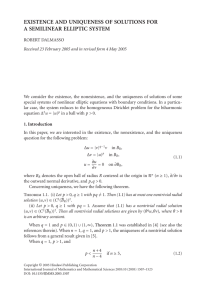Georgian Mathematical Journal 1(1994), No. 5, 477-484 ORDER LINEAR FUNCTIONAL DIFFERENTIAL
advertisement
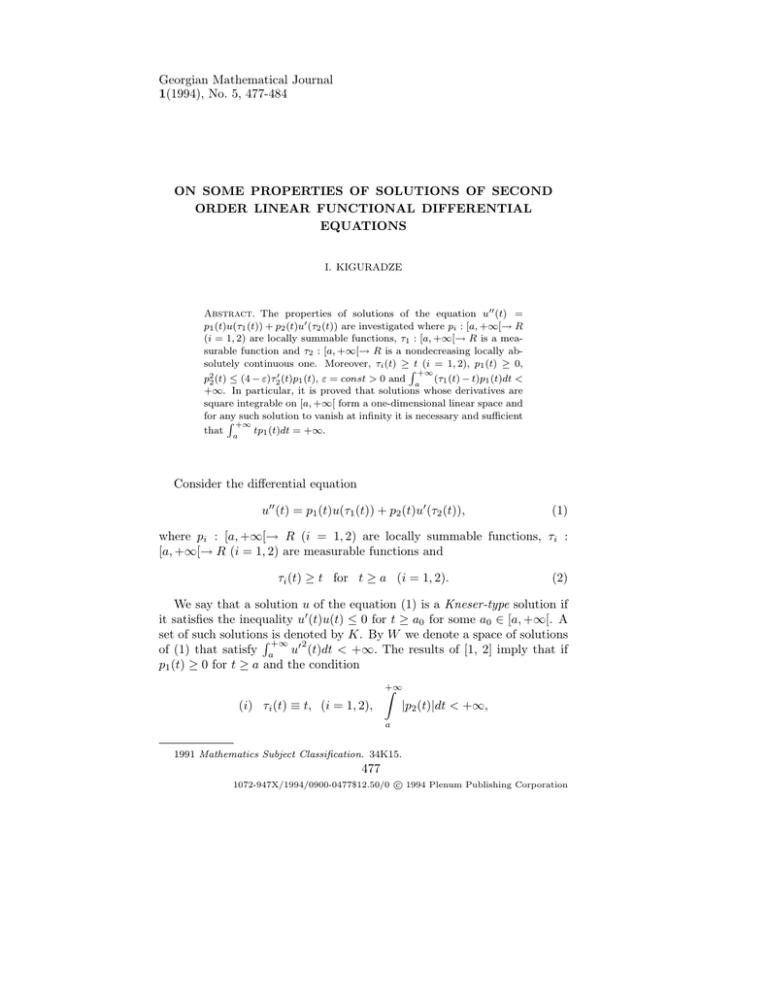
Georgian Mathematical Journal 1(1994), No. 5, 477-484 ON SOME PROPERTIES OF SOLUTIONS OF SECOND ORDER LINEAR FUNCTIONAL DIFFERENTIAL EQUATIONS I. KIGURADZE Abstract. The properties of solutions of the equation u00 (t) = p1 (t)u(τ1 (t)) + p2 (t)u0 (τ2 (t)) are investigated where pi : [a, +∞[→ R (i = 1, 2) are locally summable functions, τ1 : [a, +∞[→ R is a measurable function and τ2 : [a, +∞[→ R is a nondecreasing locally absolutely continuous one. Moreover, τi (t) ≥ t (i = 1, 2), p1 (t) ≥ 0, R +∞ (τ1 (t) − t)p1 (t)dt < p22 (t) ≤ (4 − ε)τ20 (t)p1 (t), ε = const > 0 and a +∞. In particular, it is proved that solutions whose derivatives are square integrable on [a, +∞[ form a one-dimensional linear space and for any such solution to vanish at infinity it is necessary and sufficient R +∞ tp1 (t)dt = +∞. that a Consider the differential equation u00 (t) = p1 (t)u(τ1 (t)) + p2 (t)u0 (τ2 (t)), (1) where pi : [a, +∞[→ R (i = 1, 2) are locally summable functions, τi : [a, +∞[→ R (i = 1, 2) are measurable functions and τi (t) ≥ t for t ≥ a (i = 1, 2). (2) We say that a solution u of the equation (1) is a Kneser-type solution if it satisfies the inequality u0 (t)u(t) ≤ 0 for t ≥ a0 for some a0 ∈ [a, +∞[. A set of such solutionsR is denoted by K. By W we denote a space of solutions +∞ 2 of (1) that satisfy a u0 (t)dt < +∞. The results of [1, 2] imply that if p1 (t) ≥ 0 for t ≥ a and the condition +∞ Z (i) τi (t) ≡ t, (i = 1, 2), |p2 (t)|dt < +∞, a 1991 Mathematics Subject Classification. 34K15. 477 c 1994 Plenum Publishing Corporation 1072-947X/1994/0900-0477$12.50/0 478 I. KIGURADZE or +∞ Z sp1 (s)ds < +∞, (ii) p2 (t) ≤ 0, for t ≥ 0, a +∞ Z a s |p2 (s)|ds < +∞, τ2 (s) holds, then W ⊃ K and K is a one-dimensional linear space. The case when the conditions (i) and (ii) are violated, the matter of dimension of K and W and their interconnection has actually remained unstudied. An attempt is made in this note to fill up this gap to a certain extent. Theorem 1. Let τi (t) ≥ t (i = 1, 2), p1 (t) ≥ 0 for t ≥ a, +∞ Z τ1 (t) − t p1 (t)dt < +∞, (3) a and let τ2 be a nondecreasing locally absolutely continuous function satisfying p22 (t) ≤ (4 − ε)τ20 (t)p1 (t) for t ≥ a , (4) where ε = const > 0. Then W ⊂ K, dim W = 1. (5) Before proceeding to the proof of the theorem we shall give two auxiliary statements. Lemma 1. Let the conditions of Theorem 1 be fulfilled and let a0 ∈ [a, +∞[ be large enough for the equality +∞ Z a0 τ1 (s) − s p1 (s)ds ≤ 4δ 2 , (6) where δ = 41 [2 − (4 − ε)1/2 ], to hold. Then any solution u of the equation (1) satisfies δ Zx t 02 u (s) + p1 (s)u2 (s)]ds ≤ u0 (x)u(x) − u0 (t)u(t) + +(1 − δ) τZ(x) x 2 u0 (s)ds for a0 ≤ t ≤ x < +∞ , (7) SOLUTIONS OF FUNCTIONAL DIFFERENTIAL EQUATIONS 479 where τ (x) = ess supa0 ≤t≤x [max1≤i≤2 τi (x)]. Moreover, if u ∈ W , then +∞ Z 02 u (s) + p1 (s)u2 (s)]ds for t ≥ a0 u (t)u(t) ≤ −δ 0 (8) t and 2δ +∞ Z 2 (s − t) u0 (s) + p1 (s)u2 (s)]ds ≤ u2 (t) for t ≥ a0 . t Proof. Let u be any solution of the equation (1). Then 00 2 −u (t)u(t) + p1 (t)u (t) = p1 (t)u(t) Zt u0 (s)ds − p2 (t)u0 (τ2 (t))u(t). τ1 (t) Integrating this equality from t to x, we obtain 0 0 u (t)u(t) − u (x)u(x) + = Zx t Zs p1 (s)u(s) Zx t 02 u (s) + p1 (s)u2 (s)]ds = u (y)dy ds − 0 τ1 (s) Zx p2 (s)u0 (τ2 (s))u(s)ds. t However, in view of (4) and (6), Zx t p1 (s)u(s) τ1 (s) + 1 4δ Zx t ≤δ Zx Zs u (y)dy ds ≤ δ 0 τ1 (s) − s p1 (s)ds p1 (s)u2 (s)ds + δ t τZ(x) t Zx p1 (s)u2 (s)ds + t τZ(x) t 2 u0 (s)ds ≤ 2 u0 (s)ds for a0 ≤ t ≤ x < +∞ and − Zx t p2 (s)u0 (τ2 (s))u(s)ds ≤ (9) 480 I. KIGURADZE ≤ 2(1 − 2δ) ≤ (1 − 2δ) Zx t Zx h t i1/2 h i1/2 2 p1 (s)u2 (s) τ20 (s)u0 (τ2 (s)) ds ≤ 2 p1 (s)u (s)ds + (1 − 2δ) ≤ (1 − 2δ) Zx t Zx t 2 τ20 (s)u0 (τ2 (s))ds ≤ 2 p1 (s)u (s)ds + (1 − 2δ) τZ(x) 2 u0 (s)ds t for a0 ≤ t ≤ x < +∞. Therefore 0 0 u (t)u(t) − u (x)u(x) + ≤ (1 − δ) Zx t 02 Zx t 02 u (s) + p1 (s)u2 (s)]ds ≤ 2 u (s)+p1 (s)u (s) ds+(1 − δ) τZ(x) 2 u0 (s)ds x for a0 ≤ t ≤ x < +∞ and thus the inequality (7) holds. Suppose now that u ∈ W . Then, as one can easily verify, lim inf |u0 (x)u(x)| = 0. x→+∞ So (7) immediately implies (8). Integrating both sides of (8) from t to +∞, we obtain the estimate (9). Lemma 2. Let the conditions of Lemma 1 be fulfilled and there exist b ∈]a0 , +∞[ such that pi (t) = 0 for t ≥ b (i = 1, 2). (10) Then for any c ∈ R there exists a unique solution of the equation (1) satisfying u(a0 ) = c, u0 (t) = 0 for t ≥ b. (11) Proof. In view of (2) and (10), for any α ∈ R the equation (1) has a unique solution v(·; α) satisfying v(t; α) = α for b ≤ t < +∞. Moreover, v(t; α) = αv(t; 1). On the other hand, by Lemma 1 the function v(·; 1) : [a0 , +∞[→ R is non increasing and v(a0 ; 1) ≥ 1. Therefore the function u(·) = v(ac0 ;1) v(a0 ; ·) is a unique solution of (1), (11). SOLUTIONS OF FUNCTIONAL DIFFERENTIAL EQUATIONS 481 Proof of Theorem 1. First of all we shall prove that for any c ∈ R the equation (1) has at least one solution satisfying +∞ Z 2 u0 (s)ds < +∞. u(a0 ) = c, (12) a0 For any natural k put ( pik (t) = pi (t) for 0 for a0 ≤ t ≤ a0 + k t > a0 + k (i = 1, 2). (13) According to Lemma 2, for any k the equation u00 (t) = p1k (t)u(τ1 (t)) + p2k (t)u0 (τ2 (t)) has a unique solution uk satisfying uk (a0 ) = c, u0k (t) = 0 for t ≥ a + k. (14) On the other hand, by Lemma 1 +∞ Z 2 |uk (t)| ≤ |c| for t ≥ a0 , 2δ (s − a0 )u0 k (s)ds ≤ c2 . (15) a0 Taking (2) and (13)–(15) into account, it is easy to show that the se +∞ +∞ quences uk k=1 and u0k k=1 are uniformly bounded and equicontinuous on each closed subinterval of [a0 , +∞[. Therefore, by the Arzela-Ascoli +∞ +∞ lemma, we can choose a subsequence ukm m=1 out of uk k=1 , which is +∞ uniformly convergent alongside with u0km m=1 on each closed subinterval of [a, +∞[. By (13)–(15) the function u(t) = limm→+∞ ukm (t) for t ≥ a is a solution of the problem (1), (12). We have thus proved that dim W ≥ 1. On the other hand, by Lemma 1 any solution u ∈ W satisfies (8) and is therefore a Kneser-type solution. To complete the proof it remains only to show that dim W ≤ 1, i.e., that the problem (1), (12) has at most one solution for any c ∈ R. Let u1 and u2 be two artbitrary solutions of this problem and u0 (t) = u2 (t) − u1 (t). Since u0 ∈ W and u0 (a0 ) = 0, by Lemma 1 +∞ Z 2 2 (s − a0 )u0 0 (s)ds = 0 and u0 (t) = 0 for t ≥ a0 , a0 i.e., u1 (t) ≡ u2 (t). Remark 1. The condition (4) of Theorem 1 cannot be replaced by the condition p22 (t) ≤ (4 + ε)τ20 (t)p1 (t) for t ≥ a. (16) 482 I. KIGURADZE Indeed, consider the equation u00 (t) = 1 1 u(t) − u0 (t), (4 + ε)t2 t (17) satisfying all conditions of Theorem 1 except (4), instead of which the condition (16) is fulfilled. On the other hand, the equation (17) has the solutions −1 λi ui (t) = t (i = 1, 2), where λi = (−1)i (4 + ε) 2 (i = 1, 2). Clearly, ui ∈ W (i = 1, 2). Therefore in our case instead of (5) we have K ⊂ W , dim W = 2. Corollary 1. Let the conditions of Theorem 1 be fulfilled. Let, moreover, p2 (t) ≤ 0 for t ≥ a. (18) K = W, dim K = 1. (19) Then Proof. Let u ∈ K. Then by virtue of (18) and the non-negativity of p1 there exists t0 ∈ [a, +∞[ such that u(t)u0 (t) ≤ 0, u00 (t)u(t) ≥ 0 for t ≥ t0 . Hence +∞ Z 2 u0 (s)ds ≤ |u(t0 )u0 (t0 )|. t0 Therefore u ∈ W . Thus we have proved that W ⊃ K. This fact, together with (5), implies (19). A solution u of the equation (1) will be called vanishing at infinity if lim u(t) = 0. t→+∞ (20) Theorem 2. Let the conditions of Theorem 1 be fulfilled. Then for any solution u ∈ W to vanish at infinity it is necessary and sufficient that +∞ Z sp1 (s)ds = +∞. (21) a Proof. Let u ∈ W . Then by Lemma 1 u2 (t) ≥ η for t ≥ a0 , where η = R +∞ limt→+∞ u2 (t), and a0 (s − a0 )p1 (s)u2 (s)ds ≤ u2 (a0 )/2δ. Hence it follows that (21) implies η = 0, i.e., u is a vanishing solution at infnity. To complete the proof it is enough to establish that if +∞ Z sp1 (s)ds < +∞, a (22) SOLUTIONS OF FUNCTIONAL DIFFERENTIAL EQUATIONS 483 then any nontrivial solution u ∈ W tends to a nonzero limit as t → +∞. Let us assume the contrary: the equation (1) has a nontrivial solution u ∈ W vanishing at infinity. Then by Lemma 1 u(t)u0 (t) ≤ 0, ρ(t) ≤ η 2 u2 (t) for t ≥ a0 , where +∞ Z 2 −1 ρ(t) = (s − t) u0 (s) + p1 (s)u2 (s) ds, η = (2δ) 2 . t On the other hand, by (4), (20) and (22) we have +∞ Z (s − t) p1 (s)u(τ1 (s)) + p2 (s)u0 (τ2 (s)) ds ≤ |u(t)| = t +∞ +∞ 1/2 Z Z 1/2 ≤ (s − t)p1 (s)u2 (τ1 (s))ds (s − t)p1 (s)ds + t t +∞ Z +2 (s − t)[p1 (s)]1/2 [τ20 (s)]1/2 |u0 (τ2 (s)|ds ≤ t +∞ +∞ Z 1/2 1/2 Z 2 ≤ (s − t)p1 (s) (s − t)p1 (s)u (τ1 (s))ds + t t +∞ +∞ 1/2 Z 1/2 Z 02 0 +2 (s − t)p1 (s)ds (s − t)τ2 (s)u (τ2 (s))ds t t for t ≥ a0 . Hence by (2) and (23) we find |u(t)| ≤ +∞ +∞ Z Z 1/2 1/2 + (s − t)p1 (s)u2 (s)ds (s − t)p1 (s)ds t t +∞ +∞ 1/2 Z Z 1/2 02 +2 (s − t)p1 (s)ds (s − t)u (s)ds ≤ t t +∞ 1/2 Z ≤ 3η (s − t)p1 (s)ds |u(t)| for t ≥ a0 t (23) 484 I. KIGURADZE and therefore u(t) = 0 for t ≥ a1 , where a1 is a sufficiently large number. By virtue of (2) the last equality implies u(t) = 0 for t ≥ a. But this is impossible, since by our assumption u is a nontrivial solution. The obtained contradiction proves the theorem. References 1. I.T. Kiguradze, On the non-negative nonincreasing solutions of nonlinear second order differential equations. Ann. mat. pura ed appl. 81(1969), 169-192. 2. I.T. Kiguradze and D.I. Chichua, Kneser’s problem for functional differential equations. (Russian) Diffferentsial’nye Uravneniya 27(1992), No. 11, 1879-1892. (Received 03.08.1993) Author’s address: A. Razmadze Mathematical Institute Georgian Academy of Sciences 1, Z. Rukhadze St., Tbilisi 380093 Republic of Georgia







